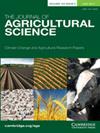Effect of Low Rate of Dicamba on Tomato (Solanum lycopersicum) at Different Growth Stages
IF 2.2
4区 农林科学
Q2 AGRICULTURE, MULTIDISCIPLINARY
引用次数: 0
Abstract
Tomatoes are highly sensitive to herbicides, and concerns have been raised regarding off-target movement of dicamba and 2,4-D with the advent of new technologies in crops like soybean and cotton. Greenhouse studies were conducted over two years to assess the effect of low rates of dicamba on tomatoes at different growth stages and investigate fruit contamination. Treatments included untreated controls and dicamba applied at 1/16X, 1/32X, 1/64X, and 1/128X rates with non-ionic surfactant (NIS). Tomato plants at three growth stages (vegetative, flowering, and fruiting) were evaluated for dicamba sensitivity. Vegetative stage plants showed the highest sensitivity, while no significant differences in injury were observed between flowering and fruiting stages. Only the untreated controls produced fruit at the vegetative stage. Plants at flowering and fruiting stages successfully produced fruits. Harvested tomato fruits from each dicamba rate and the untreated control were planted, and progeny (F1) seedlings were evaluated for dicamba symptomology. No visual dicamba symptoms were observed in the tomato progeny, indicating the absence of dicamba contamination. High-performance liquid chromatography analysis confirmed no detectable levels of dicamba in the fruit samples. These findings indicate that low rates of dicamba, even at simulated drift levels, do not significantly affect tomatoes or result in fruit contamination. The results contribute to understanding the risks associated with herbicide drift and its impact on sensitive crops like tomatoes.低剂量麦草畏对不同生育期番茄的影响
西红柿对除草剂高度敏感,随着大豆和棉花等作物新技术的出现,麦草畏和2,4- d的脱靶运动引起了人们的关注。温室研究进行了两年多,以评估低剂量麦草畏对番茄不同生长阶段的影响,并调查水果污染。处理包括未经处理的对照和麦草畏,以1/16倍、1/32倍、1/64倍和1/128倍的非离子表面活性剂(NIS)施用。番茄植株在三个生长阶段(营养期、开花期和结果期)对麦草畏的敏感性进行了评估。营养期植株的敏感性最高,花期和结实期植株的伤害程度无显著差异。只有未经处理的对照在营养期结果。开花和结果期的植物都成功结出了果实。种植不同麦草畏浓度的番茄果实和未经处理的对照,并对后代(F1)幼苗进行麦草畏症状评价。在番茄后代中没有观察到麦草畏的视觉症状,表明没有麦草畏污染。高效液相色谱分析证实,水果样品中没有检测到麦草畏。这些发现表明,即使在模拟的漂移水平下,低剂量的麦草畏也不会显著影响番茄或导致水果污染。研究结果有助于了解除草剂漂移的风险及其对番茄等敏感作物的影响。
本文章由计算机程序翻译,如有差异,请以英文原文为准。
求助全文
约1分钟内获得全文
求助全文
来源期刊

Journal of Agricultural Science
农林科学-农业综合
CiteScore
2.80
自引率
5.00%
发文量
68
审稿时长
1.4 months
期刊介绍:
The Journal of Agricultural Science publishes papers concerned with the advance of agriculture and the use of land resources throughout the world. It publishes original scientific work related to strategic and applied studies in all aspects of agricultural science and exploited species, as well as reviews of scientific topics of current agricultural relevance. Specific topics of interest include (but are not confined to): all aspects of crop and animal physiology, modelling of crop and animal systems, the scientific underpinning of agronomy and husbandry, animal welfare and behaviour, soil science, plant and animal product quality, plant and animal nutrition, engineering solutions, decision support systems, land use, environmental impacts of agriculture and forestry, impacts of climate change, rural biodiversity, experimental design and statistical analysis, and the application of new analytical and study methods (including genetic diversity and molecular biology approaches). The journal also publishes book reviews and letters. Occasional themed issues are published which have recently included centenary reviews, wheat papers and modelling animal systems.
 求助内容:
求助内容: 应助结果提醒方式:
应助结果提醒方式:


